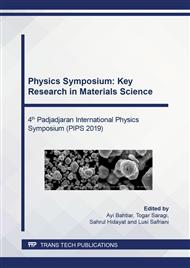p.173
p.178
p.185
p.190
p.196
p.205
p.213
p.218
p.223
Electrical Characterization of N- and B- Doped Amorphous Carbon Film from Palmyra Sugar
Abstract:
Structure of amorphous carbon can be composed of sp2 (graphite), or sp3 (diamond), or a combination of both, depending on their fractions. Therefore, many researchers were exploring to use it as solar cell material. This research used the amorphous carbon of bio-product as a basic material in the form of palmyra sugar which was synthesized through the heating and doping process to produce n-type and p-type semiconductors. This research aims to analyze the effect of dopant and deposition time on electrical properties. The heating process was carried out at 250°C and the doping process was carried out by adding NH4OH for a-C:N and H3BO3 for a-C:B. The deposition process was carried out by the nano-spray method using a variety of deposition time on the ITO substrate. The result of scanning electron microscopy (SEM) showed that the film thickness increased with the increase of deposition time. Besides, the result of four-point probe (FPP) showed that the dopant can increase electrical conductivity, but the film thickness did not influence it. The electrical conductivity obtained was 5x10-1 - 6x10-1 S/cm. And the result of further analysis, it can be concluded that electrical conductivity was still in the range of semiconducting material.
Info:
Periodical:
Pages:
196-201
Citation:
Online since:
August 2020
Keywords:
Price:
Сopyright:
© 2020 Trans Tech Publications Ltd. All Rights Reserved
Share:
Citation:


